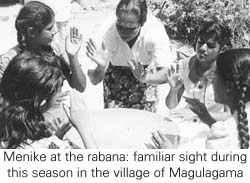 |
 12th April 1998 |
Front Page| |
Bring out the rabana, Avurudhu is here!By Chamintha Thilakarathna.
"Domisi thakata thath gunda gunda, domisi thakata thath gunda gunda," the rhythm of the drum is heard blending with the raban kavi, songs sung as one comes closer to her home. For over 38 years the rabana has been her close companion which she takes out not only during the Sinhala and Tamil new year but also whenever there is a wedding in the village. Not suprisingly she is known in the village as the raban specialist. "I started playing the instrument at the age of about twelve. In our villages people played the rabana frequently and for my luck I met a guru who taught me the various rhythms and styles," Menike said. Since then she has never lost touch, even after marriage and domestic responsibilities. Now a mother of three sons, two of whom are soldiers she has taken the challenge of training young girls in the village in order to save the art form. Herath Banda, one of the villagers, said that in his day, the rabana came out of the storeroom long before the koha came onto the trees. "The entire village would come together when it is being played and the playing goes on till one can play no longer. We used to serve tea and betel till morning sometimes. Most often what was played was Wadha kavi (where a debate is carried out in the form of songs and drum beats)," he said. There are several types of rhythms and songs, according to Menike. Some of them are the wadha padha, gemi padha (village songs), wannam padha (traditional dance songs), Sural padha (songs that are played by the fingers), Deth Haramba padha (rhythms played by the hands), and dolos haramba padha (rhythms that are played by six people making use of twelve hands). Most of the rhythms are much more complicated than the Udapala Gaththath Wattaka or Uding Uding wara pettappu that we in the cities know of. As in the case of wadha kavi. "Kalu mama avadha bola, (Has Kalu mama arrived) to which the other group replies, "Kalu mama aweth ne, (Kalu mama did not arrive) If one rhythm is played with one's fingers, the next rhythm will be played with the palms and fingers, or even with the elbows. Yet another rhythm will be played while dancing around the rabana or by placing a bunch of keys, bangles, or even the betel tray on the drum to give variations. "I do not approve of the method where keys, bangles and other items are used to play the drum," said Menike. She believes using such items spoils the leather of the drum which has been heated, although it gives a pretty sound. The preparation of the traditional rabana for any occasion is simple. The drum which is made of jak wood for the base and goat skin is held in front of a fire before playing. This is to improve the sound ,to help the sound to carry and for clarity. A special stool is also used to keep the drum on. According to Former Cultural Minister V.J.M.Lokubandara, the "Rabana" though some believe is a derivation of a foreign word, has many local associations. "Sound is implied by "Ra" and improvisation of the sound by "ban", which makes it raban," he said. Veteran drummer and dancer, Panibharatha said that the tradition of rabana has existed for over 200 years and is sad that it seems to be heading towards extinction. The villagers of Magulagama in Kuliyapitiya feel this is due to the trend towards modern music and sounds which looks down on the traditional forms of music and song. They are more than grateful to Ranasinghe Menike for teaching children of around twelve and thirteen the art of playing the Rabana. "At least this custom will remain here in our small community," they said. According to Menike the history of the instrument goes back to the days of King Mahasammathatha. The mythical story states that six Brahmins made the Rabana. The king of that time, Maha Sammaththa, apparently had a longing to hear the sound produced by the unknown musical instrument. The Brahmins were invited and they played to the king. The queen who had been a silent listener while the playing was in progress, made a request to the king that she would like to listen to it again and again. The queen learnt to the play the Rabana and she got others to learn it so that they could play for her pleasure. That is how according to Menike the Raban came to life. Continuing the tradition, she has taught the art for over twenty years and she has formed a team of players who take part in avurudhu and other festive celebrations as well. The sounds of "dontha babakkata, denta deyak netha, pettagamak uda, thuttu dekak atha," will live on in Magulagama for years to come thanks to people like Ranasinghe Menike. |
||
 |
More Plus * It's a miracle,it's a mystery, yet...
Front Page| News/Comment| Editorial/Opinion| Business| Sports | Mirror Magazine |
|
 |
Please send your comments and suggestions on this web site to |
|
 Ranasinghe
Menike's house is well hidden in the outskirts of Magulagama in Kuliyapitiya,
but cannot be missed, especially this season. This is because of the familiar
raban sound which comes from her home. The almost ripe and ready to pluck
cadju fruits dance to the rhythms as Menike plays on the drum with the
rest of the young village folk.
Ranasinghe
Menike's house is well hidden in the outskirts of Magulagama in Kuliyapitiya,
but cannot be missed, especially this season. This is because of the familiar
raban sound which comes from her home. The almost ripe and ready to pluck
cadju fruits dance to the rhythms as Menike plays on the drum with the
rest of the young village folk.